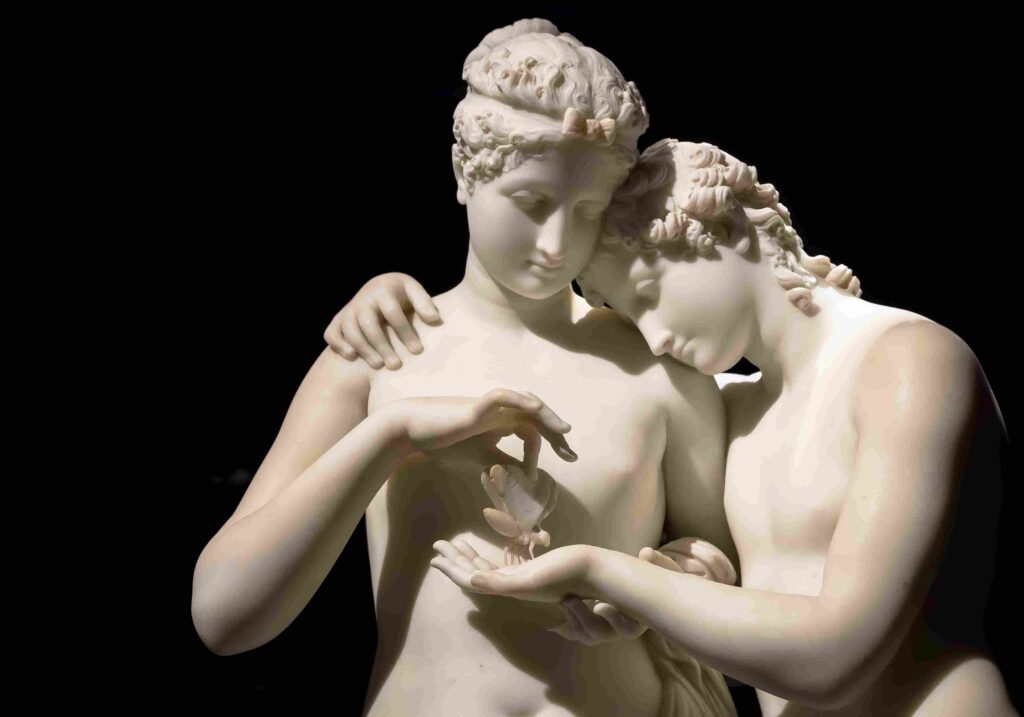
Does another version of the Cupid and Psyche statue really exist? Indeed, even though the other two versions are the most renowned and widely recognized. The first version was commissioned by the colonel Campbell in 1786, the second by Empress Catherine II of Russia. Both represent love and psyche lying in each other's arms.
However, there is another version that is less known and talked about, but also representative of unique beauty. Once again in 1800, Colonel Campbell, clearly captivated by the beauty of the love story, commissioned Antonio Canova for another work. This time the position of the two lovers involved a change.
The statue depicts the intertwined lovers standing in unity, leaning on each other, and sharing a profound gesture to express their profound love: Psyche presents Cupid with a butterfly, symbolizing her soul. Did you know that in ancient Greek, the butterfly is named “Psyche” after the lady whose name translates to “soul”? It's quite an intriguing etymological curiosity!
With an almost imperceptible gesture, Psyche surrenders her entire soul to Cupid, showcasing an extraordinarily moving manifestation of pure love.
The position and gestures of the two lovers in this version of the sculpture not only differ from the other two versions, but there is also a clear distinction in their portrayal. The absence of Cupid's customary wings in this representation may cause the artwork to go unnoticed by visitors who struggle to recognize that it's Cupid.
Cupid is represented as a human being, like Psyche, in all his most mortal form and far from the world of the gods. Probably to represent them as one, united in destiny despite their very different origins and linked forever.
Where is this sculpture displayed? At the Louvre Museum in Paris! Except that it is less photographed and less acclaimed… in our opinion it is worth discovering. Originally commissioned by John Campbell, who was struggling with economic difficulties, the work was later acquired by Josephine of Beauharnais, the first wife of Emperor Napoleon I.
This captivating and romantic piece evokes a profound emotional response, highlighting the exquisite attention to detail by the artist. Canova's style is defined by its precision and meticulous attention to detail, reflecting his meticulous study process prior to sculpting the marble. Before the sculpting process began, the artist closely examined the intricate details of the sculpture by creating plaster casts.
How do we know this? Because it is possible to see the models used by Canova, still perfectly preserved today!
These plaster casts and also other clay models are preserved in the Canova Gipsoteca, the museum in the province of Treviso, in the Veneto region, dedicated to the collection that contains the working and artistic process of Antonio Canova. It is also possible to visit the museum with guided tours!
We owe our gratitude to Giovanni Battista Sartori, the half-brother of Canova, for giving us the remarkable chance to behold these one-of-a-kind pieces that were utilized by the artist as both models and practice for his masterpieces. Recognizing the artistic value of his half-brother, Sartori transported the works from Rome to Possagno, Canova's birthplace, to preserve a remarkable collection of casts and other artistic treasures.
Have you seen how many secrets are hidden behind works that we are used to seeing? That of Cupid and Psyche is one of the most beautiful love stories that have been told since ancient times. A story so fascinating that it was one of the most represented by Canova. And which work do you like the most? “Cupid and Psyche embracing” or “Cupid and Psyche standing”?

